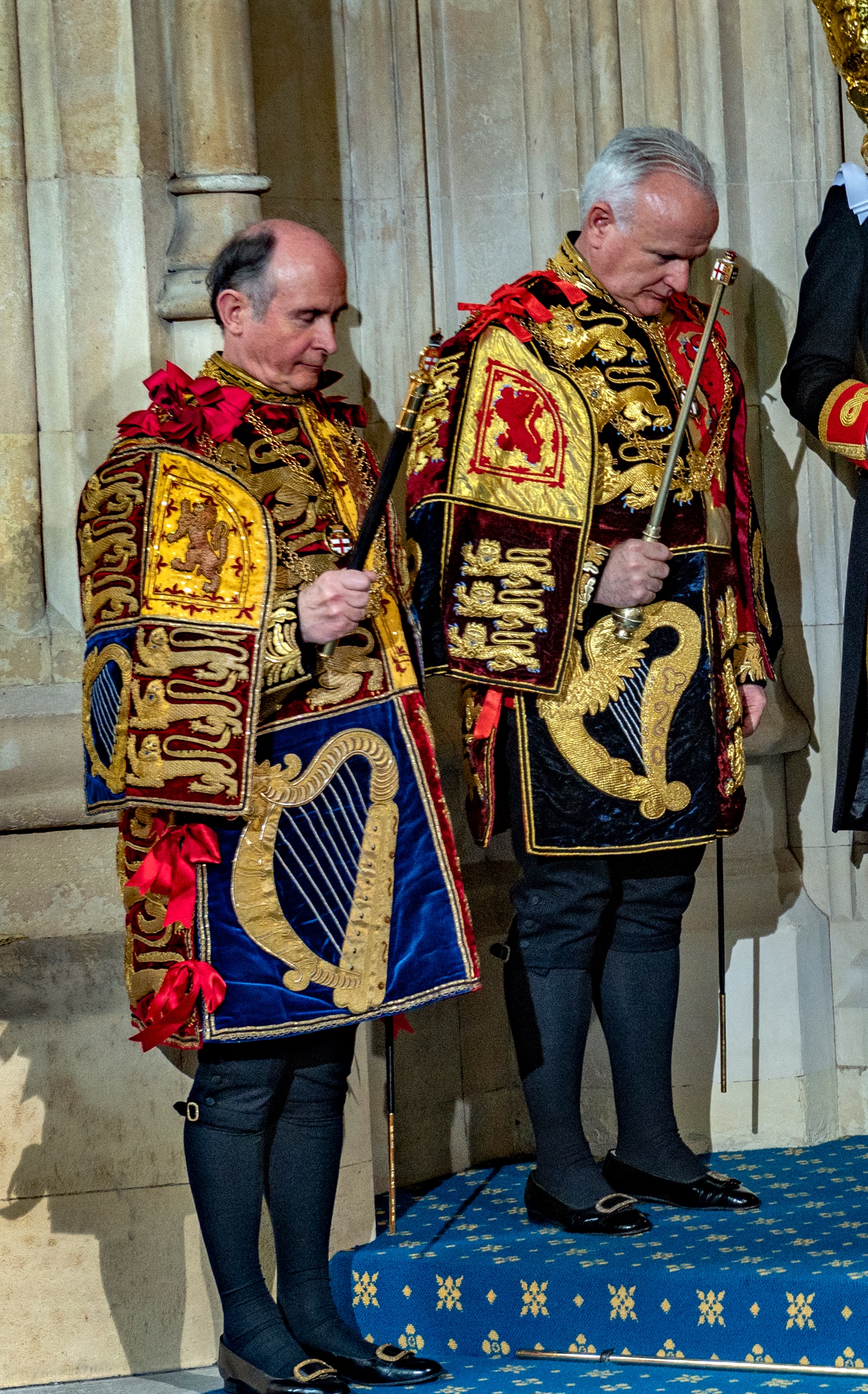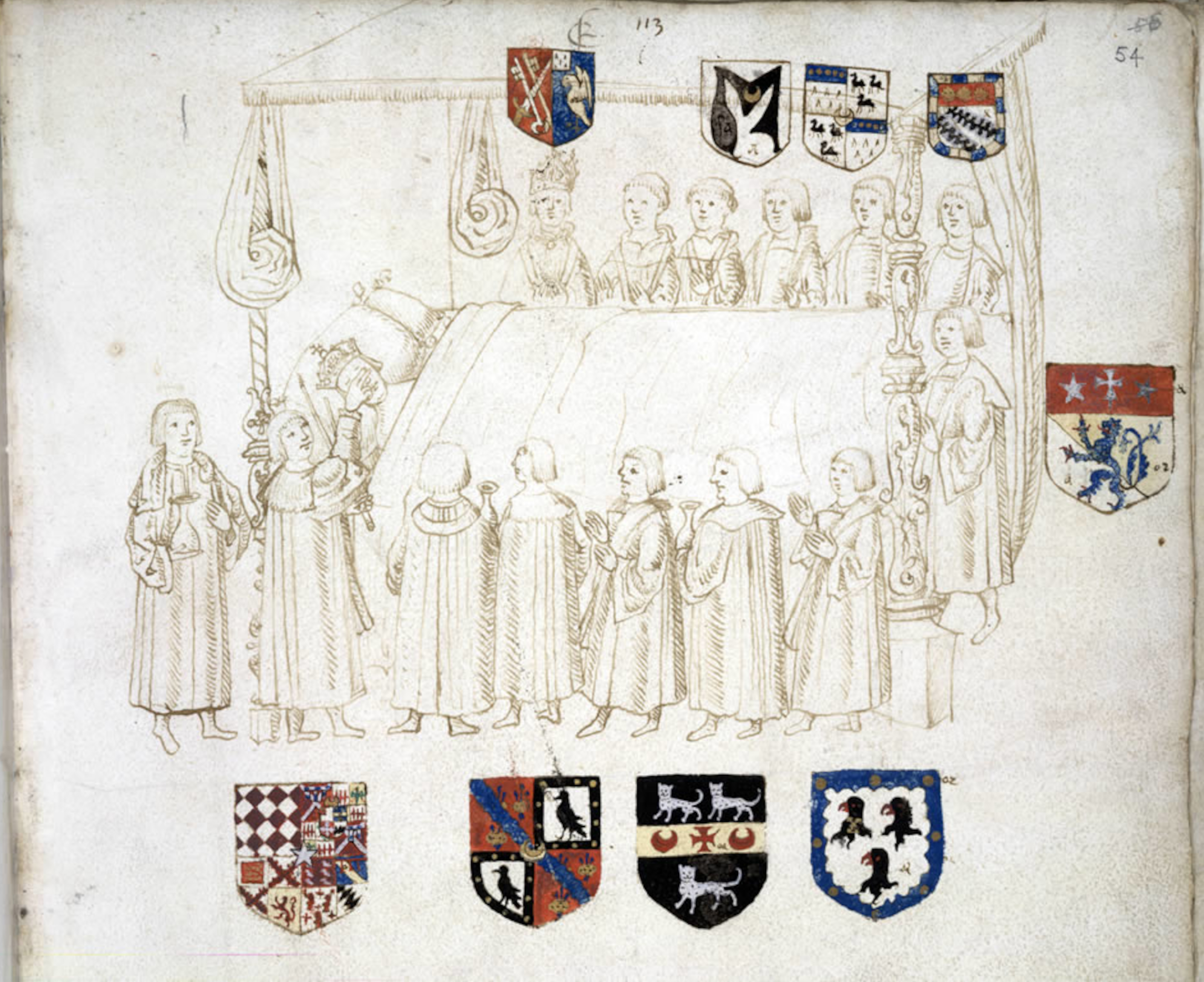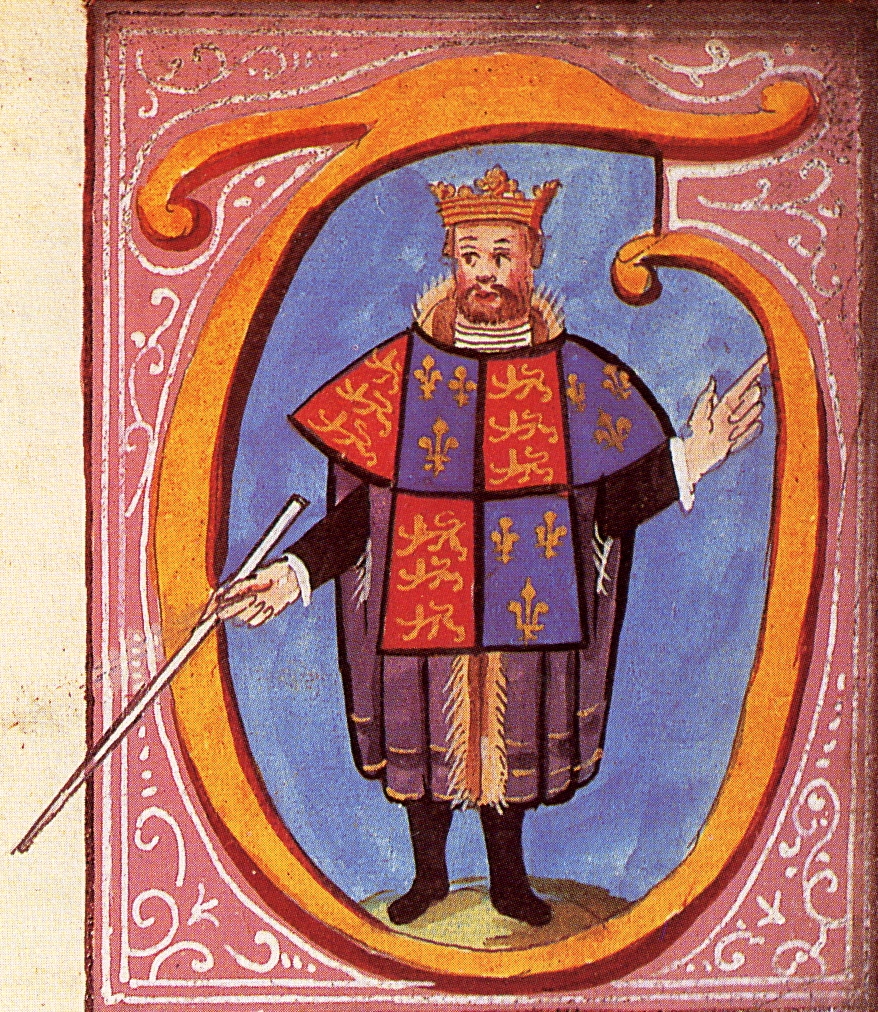|
John Writhe
John Writhe (died 1504) was a long-serving English officer of arms. He was probably the son of William Writhe, who represented the borough of Cricklade in the Parliament of 1450–51, and is most remembered for being the first Garter King of Arms to preside over the College of Arms. Writhe is also notable for the contention that it was he who developed the system of heraldic cadency employed by English officers of arms to the present day. Heraldic career It has been claimed that Writhe began his career as Antelope Pursuivant or Rouge Croix Pursuivant under Henry V, but this is doubtful. By February 1474 he had been appointed Falcon Herald. On 25 January 1477 Edward IV made him Norroy King of Arms and on 6 July 1478, he was promoted to Garter Principal King of Arms. Writhe officiated at Edward's funeral in April 1483 and at Richard III coronation the following July. As Garter he also took part in the coronation of Henry VII who reappointed him on 13 February 1486 with back pa ... [...More Info...] [...Related Items...] OR: [Wikipedia] [Google] [Baidu] |
Officer Of Arms
An officer of arms is a person appointed by a sovereign or Sovereign state, state with authority to perform one or more of the following functions: * to control and initiate coat of arms, armorial matters; * to arrange and participate in ceremonies of state; * to conserve and interpret heraldry, heraldic and genealogical records. By country The medieval practice of appointing heralds or pursuivants to the establishment of a Nobility, noble household is still common in European countries, particularly those in which there is no official heraldic control or Heraldic authority, authority. Such appointments are also still made in Scotland, where four Private officer of arms, private officers of arms exist. These appointments are all purely advisory. Canada Work completed by the Canadian Heraldic Authority is conducted by officers known as the herald of arms. The organization is led by the Herald Chancellor of Canada and the Chief Herald of Canada, the latter serving as the director ... [...More Info...] [...Related Items...] OR: [Wikipedia] [Google] [Baidu] |
Coat Of Arms
A coat of arms is a heraldry, heraldic communication design, visual design on an escutcheon (heraldry), escutcheon (i.e., shield), surcoat, or tabard (the latter two being outer garments). The coat of arms on an escutcheon forms the central element of the full achievement (heraldry), heraldic achievement, which in its whole consists of a shield, supporters, a crest (heraldry), crest, and a motto. A coat of arms is traditionally unique to an individual person, family, state, organization, school or corporation. The term itself of 'coat of arms' describing in modern times just the heraldic design, originates from the description of the entire medieval chainmail 'surcoat' garment used in combat or preparation for the latter. Roll of arms, Rolls of arms are collections of many coats of arms, and since the early Modern Age centuries, they have been a source of information for public showing and tracing the membership of a nobility, noble family, and therefore its genealogy across tim ... [...More Info...] [...Related Items...] OR: [Wikipedia] [Google] [Baidu] |
William Wriothesley
William Wriothesley or Wrythe (pronunciation uncertain: ''RYE-zlee'' (archaic), ''ROTT-slee'' (present-day) and ''RYE-əths-lee'' have been suggested) (died 1513) was an officer of arms at the College of Arms in London. He was the second son of Garter King of Arms, John Writhe; the younger brother of Thomas Wriothesley; and the father of Thomas Wriothesley, 1st Earl of Southampton. Personal life Wriothesley was probably born in London, Middlesex, or at Colatford, Wiltshire. His name at birth was William Writhe, and he was the second son of John Writhe and his first wife, Barbara, daughter of John Castlecombe. Wriothesley lived in the Barbican in London, and was a citizen and draper. He married Agnes Drayton of London, and they had one son, Thomas, who was born in 1505, and later became earl of Southampton. Wriothesley died young, some time before 26 April 1513 when Thomas Yonge became York Herald. Heraldic career Wriothesley was appointed Rouge Croix in circa 1505, and York ... [...More Info...] [...Related Items...] OR: [Wikipedia] [Google] [Baidu] |
Windsor Herald
Windsor Herald of Arms in Ordinary is an officer of arms at the College of Arms in London. It has been suggested that the office was instituted specifically for the Order of the Garter in 1348, or that it predates the Order and was in use as early as 1338. However, it is more likely that it dates from 1364, when a pursuivant of Edward III, on bringing the king news of the victory at Auray, was rewarded by promotion to the rank of herald with the title Windsor. Thereafter there is little mention of the office before 1419, when Windsor Herald was sent to the Duke of Brittany. Since that time, the office has been maintained. The badge of office is the sunburst badge of Edward III (Edward of Windsor) royally crowned. The best-known Windsor Herald was the 17th-century antiquarian, Elias Ashmole. The current Windsor Herald of Arms in Ordinary is John Allen-Petrie, Esq. Holders of the office See also * Heraldry * Officer of Arms References ;Citations ;Bibliography * ''The College ... [...More Info...] [...Related Items...] OR: [Wikipedia] [Google] [Baidu] |
Charles Wriothesley
Charles Wriothesley ( ''REYE-əths-lee''; 8 May 1508 – 25 January 1562) was a long-serving officer of arms at the College of Arms in London. He was the last member of a dynasty of heralds that started with his grandfather— Garter Principal King of Arms John Writhe. Personal life Charles Wriothesley was a younger son of Thomas Wriothesley, who also became Garter King of Arms, and his wife, Jane Hall. His uncle, William Wriothesley, had also served at the College of Arms as York Herald. Charles Wriothesley was born in London on 8 May 1508. In 1511, he moved with his family into Garter House, which his father had built as an embodiment of the family's rise to fame. His father sent him to Cambridge to study law. He was being educated at Trinity Hall, Cambridge by 1522.See . He has no entry in ''Alumni Cantabrigienses''. He seems to have married twice. His first wife was the daughter of a Mr Mallory. When he died at his lodgings London on 25 January 1562, however, there was no men ... [...More Info...] [...Related Items...] OR: [Wikipedia] [Google] [Baidu] |
Knight
A knight is a person granted an honorary title of knighthood by a head of state (including the Pope) or representative for service to the monarch, the church or the country, especially in a military capacity. Knighthood finds origins in the Greek ''hippeis'' and '' hoplite'' (ἱππεῖς) and Roman '' eques'' and ''centurion'' of classical antiquity. In the Early Middle Ages in Europe, knighthood was conferred upon mounted warriors. During the High Middle Ages, knighthood was considered a class of lower nobility. By the Late Middle Ages, the rank had become associated with the ideals of chivalry, a code of conduct for the perfect courtly Christian warrior. Often, a knight was a vassal who served as an elite fighter or a bodyguard for a lord, with payment in the form of land holdings. The lords trusted the knights, who were skilled in battle on horseback. Knighthood in the Middle Ages was closely linked with horsemanship (and especially the joust) from its origins in th ... [...More Info...] [...Related Items...] OR: [Wikipedia] [Google] [Baidu] |
Thomas Wriothesley
Sir Thomas Wriothesley ( ; died 24 November 1534) was a long serving officer of arms at the College of Arms in London. He was the son of Garter King of Arms, John Writhe, and he succeeded his father in this office. Personal life Wriothesley was born at Colatford Wiltshire. His name at birth was Thomas Writhe, and he was the eldest son and second of four children of John Writhe and his first wife, Barbara, daughter of John Castlecombe. The location of Colatford has not been identified, but it was either near Castle Combe or Cricklade. Wriothesley's first wife, whom he married before 1500, was Jane, daughter of William Hall of Salisbury. The pair had ten children together, though their only surviving son was Charles Wriothesley, Windsor Herald of Arms in Ordinary. His second wife was Anne, widow of Robert Warcop with whom he had a daughter who died in infancy. Wriothesley died "worn out with age" in London, on 24 November 1534, and was presumably buried with his family in St Giles ... [...More Info...] [...Related Items...] OR: [Wikipedia] [Google] [Baidu] |
London
London is the capital and largest city of England and the United Kingdom, with a population of just under 9 million. It stands on the River Thames in south-east England at the head of a estuary down to the North Sea, and has been a major settlement for two millennia. The City of London, its ancient core and financial centre, was founded by the Romans as '' Londinium'' and retains its medieval boundaries.See also: Independent city § National capitals The City of Westminster, to the west of the City of London, has for centuries hosted the national government and parliament. Since the 19th century, the name "London" has also referred to the metropolis around this core, historically split between the counties of Middlesex, Essex, Surrey, Kent, and Hertfordshire, which largely comprises Greater London, governed by the Greater London Authority.The Greater London Authority consists of the Mayor of London and the London Assembly. The London Mayor is distinguished fr ... [...More Info...] [...Related Items...] OR: [Wikipedia] [Google] [Baidu] |
Heraldic Visitation
Heraldic visitations were tours of inspection undertaken by Kings of Arms (or alternatively by heralds, or junior officers of arms, acting as their deputies) throughout England, Wales and Ireland. Their purpose was to register and regulate the coats of arms of nobility, gentry and boroughs, and to record pedigrees. They took place from 1530 to 1688, and their records (akin to an upper class census) provide important source material for historians and genealogists. Visitations in England Process of visitations By the fifteenth century, the use and abuse of coats of arms was becoming widespread in England. One of the duties conferred on William Bruges (or Brydges), the first Garter Principal King of Arms, was to survey and record the armorial bearings and pedigrees of those using coats of arms and correct irregularities. Officers of arms had made occasional tours of various parts of the kingdom to enquire about armorial matters during the fifteenth century. However, it was ... [...More Info...] [...Related Items...] OR: [Wikipedia] [Google] [Baidu] |
Clarenceux King Of Arms
Clarenceux King of Arms, historically often spelled Clarencieux (both pronounced ), is an officer of arms at the College of Arms in London. Clarenceux is the senior of the two provincial kings of arms and his jurisdiction is that part of England south of the River Trent. The office almost certainly existed in 1420, and there is a fair degree of probability that there was a ''Claroncell rex heraldus armorum'' in 1334. There are also some early references to the southern part of England being termed Surroy, but there is not firm evidence that there was ever a king of arms so called. The title of Clarenceux is supposedly derived from either the Honour (or estates of dominion) of the Clare earls of Gloucester, or from the Dukedom of Clarence (1362). With minor variations, the arms of Clarenceux have, from the late fifteenth century, been blazoned as ''Argent a Cross on a Chief Gules a Lion passant guardant crowned with an open Crown Or''. Timothy Duke was appointed Clarenceux K ... [...More Info...] [...Related Items...] OR: [Wikipedia] [Google] [Baidu] |
Roger Machado (officer Of Arms)
Roger Machado (Portuguese language, Portuguese: ''Rogério Machado''; died 6 May 1510) was an English diplomat and officer of arms of Portuguese people, Portuguese extraction. He lived among the Portuguese merchants at Bruges in 1455. Early heraldic career The first reference to Machado's heraldic activities is as Leicester Herald on missions to the Low Countries in 1478 and 1480. As Leicester he also participated in Edward IV's funeral in April 1483. Although an inventory of his household goods in 1484 shows that he was living a comfortable married life, his failure to pay debts forced him to flee the country. Thus in 1484—the year of the incorporation of the College of Arms—Machado was importing wine from Spain. From January 1485 Machado took part in various missions abroad in the service of the Thomas Grey, 1st Marquess of Dorset, Marquess of Dorset. These were most likely missions to help the exiled Henry VII of England, Henry Tudor. Just before the Battle of Bosworth Fiel ... [...More Info...] [...Related Items...] OR: [Wikipedia] [Google] [Baidu] |
Genealogical
Genealogy () is the study of families, family history, and the tracing of their lineages. Genealogists use oral interviews, historical records, genetic analysis, and other records to obtain information about a family and to demonstrate kinship and pedigrees of its members. The results are often displayed in charts or written as narratives. The field of family history is broader than genealogy, and covers not just lineage but also family and community history and biography. The record of genealogical work may be presented as a "genealogy", a "family history", or a "family tree". In the narrow sense, a "genealogy" or a "family tree" traces the descendants of one person, whereas a "family history" traces the ancestors of one person, but the terms are often used interchangeably. A family history may include additional biographical information, family traditions, and the like. The pursuit of family history and origins tends to be shaped by several motives, including the desire t ... [...More Info...] [...Related Items...] OR: [Wikipedia] [Google] [Baidu] |





